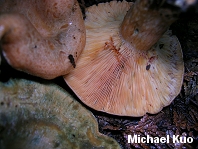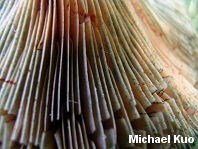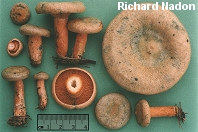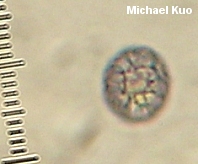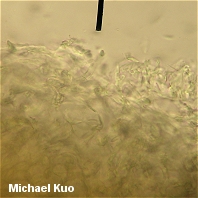| Major Groups > Gilled Mushrooms > Pale-Spored > Lactarius > Lactarius deliciosus var. deterrimus |

|
"Lactarius deliciosus var. deterrimus" [ Agaricomycetes > Russulales > Russulaceae > Lactarius . . . ] by Michael Kuo The name for this mushroom is, as my students say, all kinds of wrong (see the details below if you care). But the mushroom itself doesn't know this, and is busy helping conifers absorb nutrients in low, wet forests in Michigan--and probably throughout northeastern North America. Treated as "Lactarius deliciosus" in most field guides, and often folded together with western North America's Lactarius deliciosus var. areolatus as well as other yet-to-be-named species, Lactarius deliciosus var. deterrimus stains slowly deep red when sliced and, under the microscope, lacks prominent macrocystidia and features spores measuring about 7.5-9 X 6-7 µ. Like other mushrooms in the deliciosus group its surfaces discolor and bruise green--which helps to separate it from the non-staining Lactarius thyinos, which grows in similar ecosystems and is often found growing alongside Lactarius deliciosus var. deterrimus. Description: Ecology: Mycorrhizal with conifers--especially northern white-cedar and eastern white pine; growing alone, scattered, or gregariously in cold conifer bogs and low, wet woods; summer and fall; Michigan and, probably, throughout northeastern North America. Cap: 3-13 cm across; at first convex, becoming broadly convex, flat, or shallowly vase-shaped; slimy to sticky when wet, but often dry; the margin sometimes inrolled when young; smooth or slightly rough; carrot orange or orange, with or without concentric zones of color; stained and discolored greenish at maturity. Gills: Beginning to run down the stem; close or crowded; orange; bruising slowly red, then green; frequently entirely greenish at maturity. Stem: 2-7 cm long; 1.5-2.5 cm thick; orange; more or less equal; smooth; without potholes; often becoming hollow; bruising and staining like the cap. Flesh: Pale orangish; staining slowly deep purplish red when sliced, especially in the stem base and over the gills. Milk: Orange; staining tissues slowly deep red, then green. Odor and Taste: Odor not distinctive; taste mild to slowly slightly acrid. Spore Print: Pale buff. Microscopic Features: Spores 7.5-9 x 6-7 µ; ellipsoid; ornamentation 0.5-1.0 µ high, as amyloid warts and ridges forming partial reticula. Macrocystidia absent. Pileipellis an ixocutis. REFERENCES: (Gröger, 1968) Hesler & Smith, 1979. (Kauffman, 1918; Barron, 1999; Roody, 2003; McNeil, 2006.) Herb. Kuo 09019401. The name Lactarius deterrimus was coined by Gröger for a European species associated with spruces. Hesler and Smith (1979) applied the name to their Michigan collections from the deliciosus group--but they reduced Gröger's species name to varietal status in the process. Thus, when Gröger's species was later found to be phylogenetically distinct and limited to Europe, Hesler and Smith's mushroom was left with a thoroughly inappropriate name . . . which we are forced to use since there are no taxonomic alternatives. However, since the name Lactarius deliciosus var. deterrimus has been misapplied in many contexts (for example, as applying to western North American material) the clearest way to refer to the mushroom described here is probably "Lactarius deliciosus var. deterrimus sensu Hesler & Smith," despite the apparent redundancy of citing a name in the sense of the people who created the name. This site contains no information about the edibility or toxicity of mushrooms. |
© MushroomExpert.Com |
|
Cite this page as: Kuo, M. (2011, March). Lactarius deliciosus var. deterrimus. Retrieved from the MushroomExpert.Com Web site: http://www.mushroomexpert.com/lactarius_deliciosus_deterrimus.html |
